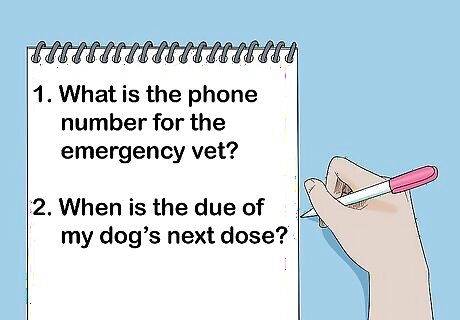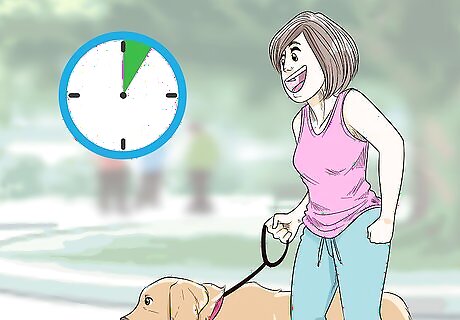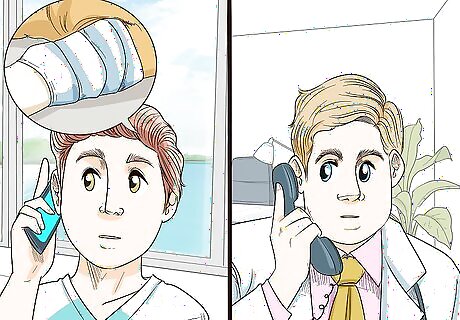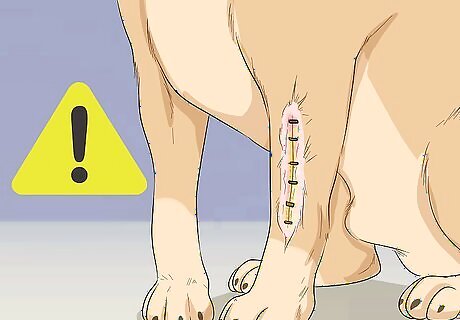
views
Taking Your Dog Home

Write down any questions you have about post-operative care while your dog is at the vet clinic. These might be queries such as the phone number for the emergency vet, if you have concerns once you get home. Also, if the dog is on medication, make sure to ask about when its next dose is due (day patients may be given their meds by injection, so it might not be necessary to give it medication the evening it is first home). In the excitement of seeing your pet again it is all too easy for questions to fly out of your mind. The vet or vet tech will give you plenty of information at the time of discharge, but take a moment to check that all your questions have been answered.

Double check that you have collected all the medications your dog needs. Read the labels to be clear of any instructions, such as if the pills should be given with or without food and if they need to be given at a certain time of day.

Understand that the vet will not let an animal go home unless it is alert and able to walk. However, just because it is up on its feet, doesn't mean it should walk home (indeed, the veterinarian will not release an animal who is incapable of moderate exertion).This is because exercise may rub or chafe the fresh wound and cause unnecessary pain and discomfort.

Ask a friend help you get your pet home. Plan to carry it in your arms or drive it home. It is best to take a friend along when you collect the pet, and have the friend drive so you can focus your attention on the dog (and not get distracted on the road!) It is also useful to have an extra pair of ears to listen to all those instructions at the clinic.

Lift your dog into the car. If the dog has a wound or an incision, you need to avoid stretching that area. If possible, lift the dog into the car rather than have it jump in. For a large dog this might mean asking for assistance to lift it onto the back seat, or using a ramp to walk it into the trunk. Likewise, back home, assist it out of the car so that it doesn't jump out and stretch its stitches. If it does jump out, don't panic! Stretching the wound will cause temporary discomfort but is unlikely to do permanent harm.
Managing the First Evening After Surgery

Give your dog the water it needs. Unless the dog has been on intravenous fluids during its procedure, it will be thirsty. Once home, offer it some fresh drinking water so that it can freshen its mouth and quench its thirst. If it chugs lots of water at once, the water may hit its stomach and make it vomit. This is because its system has been empty for nearly 24 hours and a sudden impact of a bowl of cold water may make the stomach spasm. If the dog seems intent on drinking a whole bowlful, ration the water and allow it a teacup full every half an hour for two hours, after which time it can drink freely.

Feed your dog a bland meal. After an anesthetic it is common for the dog's stomach to be sensitive and feeding its regular food may make it vomit. To avoid this, the first meal after an anesthetic should be bland food that is easy to digest. The clinic may send your dog home with a tin of a prescription diet such as Hills ID or Purina EN. These foods are formulated to be gentle on the stomach and are ideal after surgery, even surgery on the bowel itself. If your dog doesn't like the prescription diet, then the next best option is a bland meal of white meat, such as chicken, turkey, cod, or coley fish, with the addition of boiled white rice or pasta. If the dog refuses to eat the chicken and rice, then skip that evening's meal, and the following morning offer its regular food (unless given different instructions by the vet).

Let your dog sleep. After a day spent in the unfamiliar surroundings, many dogs are tired when they come home. Once safely home it may allow itself to relax and go into a deep sleep. This is a good thing, so make sure it is in a warm, draft-free place and leave it undisturbed. Sleep is a good sign that it is not in discomfort, because a dog in pain may well be restless.

Know that your dog’s pain medication may wear off. Modern anesthetics are short acting and are rapidly metabolized out of the dog's system over the course of a few hours. At this point some dogs then become restless when the lingering pain-numbing effect from anesthesia is lost. How sore it is depends on what other pain-relief (analgesia) the dog has received, but most clinics cover the patient for a 24 hour period with an injection of an non-steroidal anti-inflammatory drug (NSAID) such as meloxicam.

Consider your dog’s pain threshold. How well the dog deals with discomfort depends on its pain threshold. Some dogs are stoical and never complain, whilst others whimper and whine with the slightest discomfort. It helps if you have some idea of how your dog is likely to behave, since this helps interpret its behaviour after surgery.

Look for signs that something has gone wrong. The night after surgery, it is helpful to know the signs of a problem, and when to contact the vet. If you notice the following, contact your vet. Excessive seepage from the wound: Some seepage from a wound is normal, but usually limited to a few spots of blood-stained straw coloured fluid. If the discharge is pure blood, or if fluid drips from the incision then phone the vet. This may well just be ooze from tissue beneath the skin, but do not hesitate to seek professional advice. Whining or vocalization, signs of distress: Signs of distress include crying, whining, howling, and an inability to settle. This needs to be interpreted with a view to how stoic your dog is (ie. a hardy Rottweiler whining is more significant than a Chihuahua who is distressed more easily). If in doubt contact the vet. They may be able to advise about bringing forward the next dose of pain relief. Unresponsive or collapsed: Being deeply asleep is one thing, but being collapsed and non-responsive is another. If the dog is conscious (ie not asleep) but is not able to stand when roused, or cannot lift its head up, phone for urgent advice. Repeated vomiting: If the dog is repeatedly sick, phone for advice. Anesthetic agents can irritate a dog's stomach, and make it difficult for it to keep fluid down. If vomiting continues, the dog may need an anti-sickness injection to settle its tummy or risk becoming dehydrated.

Notice normal behavior after surgery. There is no denying that even with modern pain relief, your pet may feel uncomfortable after surgery. It is to be expected that it will not be its normal self, especially the first night home. To help prepare you for what to expect, the following are often "normal" after surgery. Sleeping deeply: In the unfamiliar surroundings of a vet surgery, the pet is likely to stay awake more than it would in the peace of its own home. Once home, it may well relax and catch up on its rest by going into a deep sleep. Unable to settle: Some pets come home and want to thoroughly check out their territory, to sniff out who has been intruding in their absence. The pet may wander from room to room and seem unable to settle. Once fully assured that everything is in the right place, it is likely to relax. Being growled at by other pets: A dog or cat that spends a day at the vet clinic is going to smell strange to its companions. Animals use their sense of smell much more than we do, and may hiss or growl at a pet that looks like one they know but smells different. If this happens, simply keep the pet in a separate room overnight so that it picks up "homely" smells. Refusing food: A combination of being out of routine and being sore is sufficient to make some pets refuse their first meal once home. Don't be overly concerned by this; the chances are the pet will chow down in the morning. Decreased need to go to the toilet: In preparation for the anesthetic, the pet will have been starved from the previous evening, and its gut is not as full as usual. It may well be that it skips a bowel movement or two. It is not constipated, but just does not need to pass a stool. Likewise, anesthetics are slightly dehydrating so the pet may not urinate as frequently (during the first 24 hours post surgery) or produces a smaller puddle. Tenderness near the incision: Sensitivity around a surgical incision is to be expected. Depending on the animal’s temperament, some may even growl or hiss to warn you away from the site. Respect this warning.
Caring for Your Dog’s Wound

Keep your dog from licking its incision. It is a myth that dog saliva has healing properties. Licking is likely to either colonize the incision with bacteria from its mouth or pull the stitches out. To prevent it from licking the wound, you will either have to use a buster collar, a dressing, or a covering such as a T-shirt.

Get your dog a buster collar: Otherwise known as the "cone of shame" these are plastic collars that fit around the head like an upside down lampshade. The idea is to provide a barrier between the tongue and the wound. The collar is best left on at all times. The dog may not like wearing it but it will get used to it. Many dogs are secretive lickers and if you remove the collar thinking it can be trusted, it is likely it will wait until alone and then lick.

Wrap the wound up with bandages. Areas such as a paw or leg are amenable to bandaging, which keeps the wound clean and protected. However, make sure to keep the bandages clean and dry. If your dog is a chewer, it may still need to wear a buster collar so that it doesn't chew the bandage off. Avoid bandaging the wound too tightly as this may cut off circulation. It’s okay to wrap the bandage with plastic to keep it clean and dry when your dog goes out to use the bathroom, but remove the plastic when your dog comes back inside to ensure that the wound can breathe.

Cover the wound by putting a t-shirt on your dog. Incisions on the trunk can be covered with a T-shirt. Choose a T-shirt that is large enough to cover the necessary area, and put the dog's head through the T-shirt neck, and forelegs through the arm holes. Tie the hem of the T-shirt in a knot to secure the lower end. Do not use safety pins since these pose a swallowing hazard. T-shirts are especially useful if you have a couple of dogs, and the companion licks its friend.

Keep the incision clean and dry. When possible cover the wound (as described in the previous steps) when the dog goes out to relieve itself. If the incision gets splashed with mud or dirt, clean it gently. Clean the wound with diluted salt water. Boil the kettle and allow the water to cool. Mix 1 teaspoon of salt into 1 US-pint (470 ml) of previously boiled water, and keep this as your stock solution. Soak a clean pad of cotton wool in the salt solution and squeeze out the excess moisture. Use the moist pad to gently wipe away contamination. Pat the area dry with a clean towel.
Managing the Days After Surgery

Understand that your dog must rest in order to heal. After surgery, strict rest is essential during the convalescent period until the stitches are removed. The timing of suture removal depends on the nature of the surgery but is usually 10 to 14 days after the operation. The principle of strict rest is to not stretch to incision or overexert the animal. Thus going up and down stairs is forbidden, as is jumping on and off furniture. The consequences of not preventing these actions include pain, stitches slicing the skin, swelling at the op site, and the worst case scenario of wound breakdown (the stitches bursting and the incision opening up).

Limit the movements that your dog can make. The first two to three days after surgery are most critical with regards to rest because in these early stages the wound is healing rapidly. The dog should not be taken for walks. It should be put on a collar and lead when it goes out to relieve itself (just in case it sees a cat and wants to give chase!). If your dog is boisterous then speak to your vet about sedation.

Transition into short walks when the vet says it is ok to do so. Most patients have a post-operative exam two to three days after surgery. If the wound is healing well, the veterinarian may sanction gentle 5 minute lead walks, but this should not be assumed.

Monitor your dog’s bowel movements. It is not unusual for a dog's bowel habits to be out of routine for a few days. This is because it was starved prior to surgery and skipped a couple of meals, so its system will be empty for a day or so. Monitor it to check when it passes feces and make sure it is not diarrhea. Diarrhea is not uncommon after an anesthetic, and if it has diarrhea, stick with the bland diet and let your veterinarian know. Do not give a NSAID medication such as meloxicam if the dog has diarrhea because this medication can impair blood circulation to the bowel wall and worsen existing diarrhea.

Understand that it may take longer for your dog to relieve itself. If the dog has abdominal sutures it may be sore to strain and move its bowel. Do not worry if it takes longer than usual to manoeuvre for that first post-surgery bowel movement. Things will get easier. If it has not moved its bowel by the third day after surgery, let the vet know at the post-operative check. The vet will feel your dog's tummy to check if it is truly constipated and will determine gentle enema is necessary, or if it just needs more time for things to move along.

Feed your dog its regular food unless otherwise instructed by the vet. After that initial bland meal, (unless the dog had bowel surgery) it can go back onto its normal food. If there are sutures in the bowel then continuing with the prescription diet is ideal, or failing that a white meat diet. These foods are gentler on the bowel and less likely to either inflame the lining, or pop the intestinal sutures. The bland diet should be continued until the veterinarian tells you it is safe to resume normal feeding.
Knowing When to Contact the Vet in the Week After Surgery

Know when to contact the vet in the week after surgery. After surgery your dog will be seen back for routine checks three days and ten days after surgery. This check ups will make sure that it is healing well, and that the stitches can be removed. However, if you are worried, never hesitate to contact the clinic for advice. Signs to be alert for which may indicate a complication are listed in the following steps.

Monitor your dog for a loss of appetite. It is not unusual for a dog to refuse to eat for 24 hours after an anesthetic, but if it is longer than this, alert your vet.

Look for signs of lethargy. If the dog is unusually quiet or subdued, and especially if they refuse to move 24 hours after surgery, let the clinic know.

Contact the vet if your dog repeatedly vomits or has diarrhea. Whilst it is not unusual for a dog to vomit bile once or twice after an anesthetic, vomiting more frequently than this may indicate a complication so you should let the vet know. Do not give further doses of pain relief until you have spoken to the clinic and made sure it is safe to do so.

Check to see if the incision is swollen or feels hot. The area beneath the sutures may swell because of suture reaction, which is where the body activates the immune system to try to reject the "foreign" suture material. This is not dangerous in itself, but it is difficult for a non-veterinary professional to differentiate this from a hernia (a hole in the body wall) which is potentially serious. If the wound is swollen or hot, then alert the clinic.

Look out for excessive discharge from the wound. In the first 24 to 48 hours after surgery you may notice spots of blood-stained serum from the incision. Monitor the amount produced and if it increases from the odd spot to a steady drip, contact the vet. Likewise, if the discharge is purulent (creamy, yellow, or green colored) then contact the vet.

Watch for burst stitches. If stitches are missing, especially if there is a gap along the line of the incision, contact the surgery. It is not always necessary to replace one or two missing sutures, but additional antibiosis may be required to protect against infection if tissue beneath the skin is exposed.




















Comments
0 comment